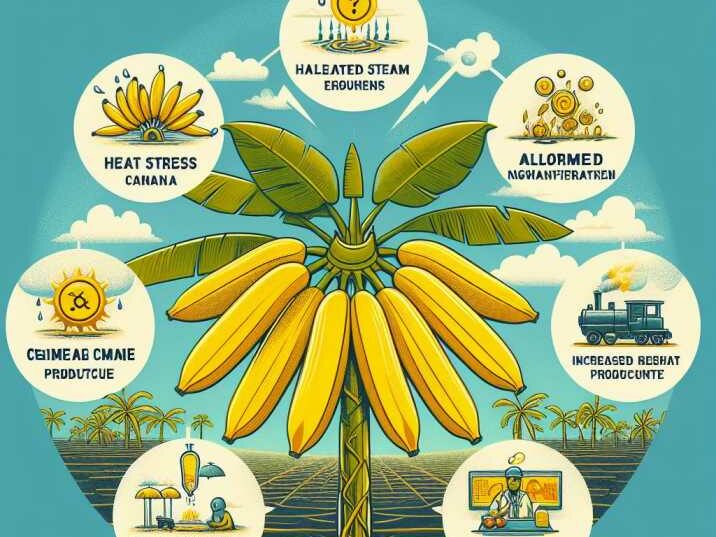Introduction:
Table of Contents
Cavendish bananas, the beloved yellow fruit adorning breakfast tables and lunchboxes around the globe, face an uncertain future due to the profound impacts of climate change. As temperatures rise, rainfall patterns shift, and extreme weather events become more frequent, the delicate balance required for successful banana cultivation is disrupted. In this article, we’ll explore the intricate relationship between the effects of climate change on Cavendish banana Production, uncovering the challenges faced by farmers and consumers alike.
The Rise of Cavendish Bananas:
Cavendish bananas have long been a staple in diets worldwide, prized for their sweet taste, convenient packaging, and nutritional value. However, the widespread adoption of this particular banana variety also brings vulnerability to environmental changes. Originating from Southeast Asia, Cavendish bananas were introduced globally as a replacement for the Gros Michel variety, which was decimated by the Panama Disease in the mid-20th century. The resistance of Cavendish bananas to the disease made them the preferred choice for commercial cultivation. Yet, this very ubiquity now exposes them to new threats, primarily stemming from climate change.

Understanding The Effects of Climate Change on Cavendish Banana Production:
Temperature Extremes and Heat Stress:
One of the most significant challenges posed by climate change is the increase in temperature extremes. Rising temperatures can lead to heat stress in banana plants, affecting their growth and productivity. Bananas thrive in warm, humid climates, but excessive heat can disrupt essential physiological processes, such as photosynthesis, ultimately reducing yields.
Altered Rainfall Patterns:
Changes in rainfall patterns further compound the challenges faced by banana growers. Bananas require consistent moisture throughout their growth cycle, and any deviations from this can impact fruit development and quality. Droughts and floods, both exacerbated by climate change, disrupt irrigation schedules and soil moisture levels, making it difficult for farmers to maintain optimal growing conditions.
Pest and Disease Pressure:
Climate change also influences the distribution and prevalence of pests and diseases that affect banana crops. Warmer temperatures create more favorable conditions for pests like nematodes and fungal pathogens, which can devastate plantations if left unchecked. Additionally, extreme weather events, such as hurricanes and cyclones, facilitate the spread of diseases like Black Sigatoka, further compromising yields.
Adapting to a Changing Climate:
Despite these formidable challenges, farmers and researchers are actively exploring adaptation strategies to safeguard Cavendish banana production. This includes developing heat-tolerant banana varieties, implementing water-saving irrigation techniques, and adopting integrated pest management practices. Furthermore, improving soil health and biodiversity within banana plantations can enhance resilience to climate-related stresses.

Table of Information:
| Climate Change Impact | Description |
|---|---|
| Temperature Extremes | Rising temperatures can cause heat stress in banana plants, affecting growth and productivity. |
| Altered Rainfall Patterns | Changes in rainfall patterns disrupt irrigation schedules and soil moisture levels, impacting fruit development. |
| Pest and Disease Pressure | Warmer temperatures and extreme weather events facilitate the spread of pests and diseases, compromising yields. |
| Adaptation Strategies | Heat-tolerant varieties, water-saving techniques, and integrated pest management help mitigate climate-related challenges. |
Conclusion:
In conclusion, the effects of climate change on cavendish banana production is undeniable. As temperatures continue to rise and weather patterns become increasingly unpredictable, the resilience of this beloved fruit faces unprecedented tests. However, through innovation, collaboration, and sustainable practices, there is hope for mitigating these challenges and ensuring a future where Cavendish bananas remain a delicious and accessible dietary staple for generations to come.
Frequently Asked Questions:
- Q: How does climate change affect banana plants? A: Climate change can lead to heat stress, altered rainfall patterns, and increased pest and disease pressure, all of which negatively impact banana plants’ growth and productivity.
- Q: What are some adaptation strategies for banana farmers? A: Banana farmers can adopt heat-tolerant banana varieties, implement water-saving irrigation techniques, and employ integrated pest management practices to mitigate the effects of climate change.
- Q: Why are Cavendish bananas particularly vulnerable to climate change? A: Cavendish bananas are susceptible to climate change due to their widespread cultivation and reliance on specific environmental conditions for optimal growth and fruit development.
- Q: Can consumers help mitigate the impact of climate change on banana production? A: Yes, consumers can support sustainable farming practices, reduce food waste, and advocate for policies aimed at addressing climate change to indirectly contribute to mitigating its impact on banana production.
- Q: What can be done to ensure the long-term viability of Cavendish banana cultivation? A: Investing in research and development, promoting agroecological approaches, and fostering international cooperation are key to ensuring the long-term viability of Cavendish banana cultivation in the face of climate change.
